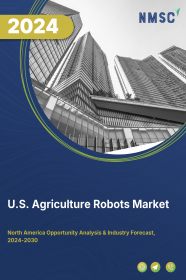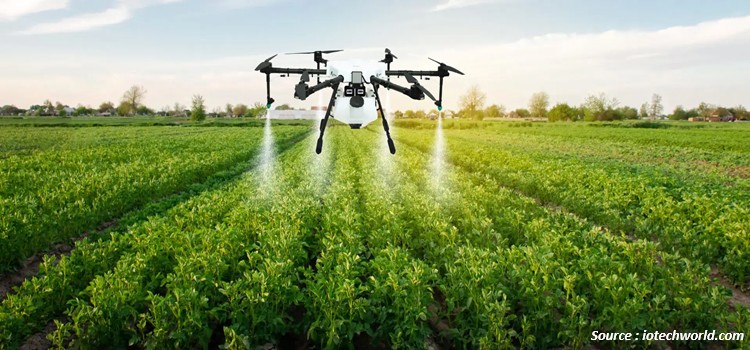
U.S. Agriculture Robots Market by Type (Driverless Tractors, Unmanned Aerial Vehicles (UAVs), Milking Robots, Automated Harvest Robots, and Others), Offering (Hardware, Software, and Services), Farming Type (Indoor Farming and Outdoor Farming), Application (Dairy Management, Irrigation Management, Harvest Management, Soil Management, Inventory Management, and Others), and End User (Field Crops, Fruits & Vegetables, Livestock, and Others) – Opportunity Analysis and Industry Forecast 2023–2030
Industry: Agriculture | Publish Date: 17-Dec-2024 | No of Pages: 87 | No. of Tables: 73 | No. of Figures: 31 | Format: PDF | Report Code : AG616
US Tariff Impact on U.S. Agriculture Robots Market
Trump Tariffs Are Reshaping Global Business
Market Definition
U.S. Agriculture Robots Market was valued at USD 1.92 billion in 2022, and is predicted to reach USD 5.78 billion by 2030, with a CAGR of 13.6% from 2023 to 2030. Agriculture robots, also known as agribots, are a new technology that is transforming the way of farming. These robots are designed to perform a variety of tasks, from planting and harvesting crops to monitoring soil conditions and weather patterns.
Agriculture robots use a combination of sensors, cameras, and GPS technology to navigate and perform tasks in the field. They are often equipped with robotic arms or tools that allow them to perform specific tasks, such as planting seeds or harvesting crops. These robots can also collect data on soil conditions, weather patterns, and crop growth, which can be used to optimize farming practices. Some agriculture robots are even capable of autonomous operation, which can work without human intervention. Overall, agriculture robots are a promising technology that has the potential to revolutionize the farming industry.
Increases Farm Efficiency and Productivity
The integration of agricultural robots into farming operations offers substantial opportunities to boost farm efficiency and productivity. These robots are capable of automating various tasks like planting, harvesting, and crop monitoring, which typically require a significant investment of manual labor and time. By embracing these labor-intensive processes, agriculture robots have the potential to revolutionize farm management practices.
With their precise programming and advanced sensing technologies, these robots can execute tasks with exceptional accuracy and consistency, minimizing the chances of human error and variability. This transformative technology is anticipated to drive substantial market growth by streamlining operations and delivering enhanced efficiency and productivity. As a result, the adoption of agricultural robots has the potential to reshape the way farms are managed, optimize resource utilization, reduce waste, and pave the way for significant advancements in the agricultural industry.
Technological Advancements in the U.S.
The growing technological advancements in United States such as robotics, artificial intelligence, and sensor technologies in the agricultural sector plays a significant role in driving the agriculture robots market growth. These technological advancements have played a crucial role in the development of sophisticated and capable agriculture robots. By integrating advanced technologies into these robots, they have become more intelligent, versatile, and efficient in performing a wide range of tasks. Robotics technology provides the foundation for the physical structure and movement of agriculture robots, allowing them to navigate and operate in various farm environments.
The High Initial Investment Required for Acquiring and Implementing Agriculture Robots
The high initial investment required for acquiring and implementing agriculture robots in the U.S. is a significant drawback for many farmers, especially those with limited financial resources or smaller-scale operations. The cost involved encompasses not only the purchase of the robots themselves but also the necessary infrastructure and equipment to support their deployment. Thus, it is expected to restrain the agriculture robots market growth.
Growing Technological Advancements in the U.S.
The ongoing advancements in robotics such as artificial intelligence (AI), and sensor technologies offer significant opportunities for the development of advanced agriculture robots in U.S. These technological advancements enable the creation of more sophisticated and capable robots that can revolutionize farming practices. This advancement is anticipated to drive substantial growth opportunities for the agriculture robots market.
Competitive Landscape
The agriculture robots industry includes several market players such as Verdant Robotics, Agrobotix LLC, DroneDeploy, Harvest Automation Inc., DeLaval Inc., Blue River Technology, John Deere, Lely Industries NV, EcoRobotix Ltd, and GEA Group. These market players are adopting various strategies such as innovation and collaboration to maintain their dominance in the market of U.S.
For instance, in September 2022, GEA launched GEA Dairy Feed F4500, an autonomously driving feeding robot. This new feeding robot is designed to help dairy farms reduce their carbon footprint and operating costs while boosting flexibility on the farm. For instance, in February 2022, Verdant Robotics launched a multi-functional agricultural robot aimed at elevating specialty crop farming to a superhuman level. Verdant has broadened its robot-as-a-service (RaaS) offering to make it more accessible to specialty crop farmers, leading to improved results such as increased crop production, higher yields, and cost savings.
Key Benefits
-
The U.S. agriculture robots market report provides a quantitative analysis of the current market and estimations through 2023-2030 that assists in identifying the prevailing market opportunities to capitalize on.
-
The study comprises a deep dive analysis of the market including the current and future trends for depicting the prevalent investment pockets in the market.
-
The information related to key drivers, restraints, and opportunities and their impact on the market is provided in the report.
-
The competitive analysis of the market players along with their market share in the U.S. agriculture robots market.
-
The SWOT analysis and Porter’s Five Forces model are elaborated in the study.
-
Value chain analysis in the market study provides a clear picture of the stakeholders’ roles.
U.S. Agriculture Robots Market Key Segments
By Component
-
Driverless Tractors
-
Unmanned Aerial Vehicles (UAVs)
-
Milking Robots
-
Automated Harvest Robots
-
Others
By Offering
-
Hardware
-
Software
-
Services
By Farming Type
-
Indoor Farming
-
Outdoor Farming
By Application
-
Dairy Management
-
Irrigation Management
-
Harvest Management
-
Soil Management
-
Inventory Management
-
Others
By End User
-
Field Crops
-
Fruits & Vegetables
-
Livestock
-
Others
Key Players
-
GEA Group
-
CNH Industrial
-
Delaval
-
Deere & company
-
AGCO CORPORATION
-
Trimble Inc.
-
Naio Technologies
-
Yanmar Holdings Co. Ltd.
-
SZ DJI Technology co. Ltd.
-
Boumatic
-
Harvest Automation Inc
-
Autonomous Solution Inc
-
Clearpath Robotics
-
Ageagle Aerial System
-
Kubota Corporation

















 Speak to Our Analyst
Speak to Our Analyst





















